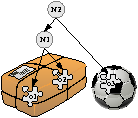Section: New Results
Integrity checking with coupled objects
Participants : Michel Banâtre [contact] , Paul Couderc, Jean-Francois Verdonck.
Integrity checking is an important concern in many activities, such as logistic, telecommunication or even day to day tasks such as checking for someone missing in a group. While the computing and telecommunication worlds commonly use digital integrity checking, many activities from the real world do not benefit from automatic integrity control mechanisms. RFID technology offers promising perspectives for facing this problem, but also raises strong privacy concerns as most of the RFID-based systems rely on global identification and tracking. Previously we have already designed Ubi-Check to provide an approach aiming at coupling physical objects and enabling integrity control built on local interactions, without the support of a global information system. Ubi-Check led to the development of various novel applications running quite on the same technology. Most of the partners showed a high interest in defining coupled object-based security solutions, but they were lacking the possibility of defining hierarchical couplings. This is that we have studied and implemented this year. We have designed the Ubi-Tree software which strives to deal with those new requirements.
Hierarchical physical object coupling
Ubi-Tree is a new solution/software designed at INRIA aiming at setting-up and reading hierarchical couplings. It relies on a structure in which physical objects (also called fragments) are seen as external nodes of a tree that we call coupling tree. External nodes of a tree are called leaves. In the system, internal nodes are called coupling nodes. Each fragment embeds an RFID tag supporting coupling data. Coupling data stores the coupling tree. Each internal node can be checked, which means a lacking, illegally forged or corrupted node can be detected at any depth of a coupling. Ubi-Tree proposes a new API to create and check hierarchical couplings and an interactive editing GUI is under development.
Coupling tree structure
New algorithms and structure to store and read hierarchical couplings trees in its leaves (RFID tags) have been developed, making it possible to use multiple coupling levels. Let's take an example: given three physical objects , , . A user can couple and together. Let be the parent coupling of and : =, . Then he couples this coupling with to create the =, , coupling node. Figure 2 gives an illustration of the described coupling.
The key idea of the coupling structure is that coupling data are spread in a way that only descendant leaves of a coupling node are required to read it and process its integrity control. This way, only needs and to be read and / or checked as and are descendants from whereas is not. This choice enables to process integrity controls at multiple coupling levels. It is very convenient, as an example, if is physically separated from and . So if , and are brought into the field of the RFID reader, and can be written, read and checked. If is not present in its field, will not be recovered from the read data but can still be read and checked. If checked, will notify it was not the root of the coupling tree when the coupling tree was written. This way, the user knows it did not read the whole structure and are part of. Indeed, coupling nodes can have the following status:
-
Valid: the set of detected tags enabled to decode a structure in which the node has the children and the parent it is supposed to have.
-
Partial: same as the valid status except the node should have a parent that could not be read from detected tags.
-
Incomplete: the node is missing some of its children.
Ongoing work
Today the management algorithms of graphs are located on the memory available RFID reading and writing. However, in the various applications envisaged, only a subset of RFID memory are read / write, others are only accessible in read-only. Currently we are working on the development of our algorithms that take into account this kind of configuration. The other problem we are working on today is the interface provided to users to be sure that the association between RFID tag and physical object is the one that is perceived by our coupling software. The idea is to be able to identify in the right way the RFID tag associated to a physical object when we place one physical object onto the support of the antenna linked to the RFID reader. The position of , and the tag associated to , in the physical space is determined using a camera coupled with an image recognition algorithm. The result is displayed onto a touch screen. In that way, when we want to couple a set of physical objects , , ...We place sequentially all these objects onto the support of the antenna, and from the image of these objects displayed onto the touch screen we touch those we want to couple and activate the coupling operation. This solution is under development.



